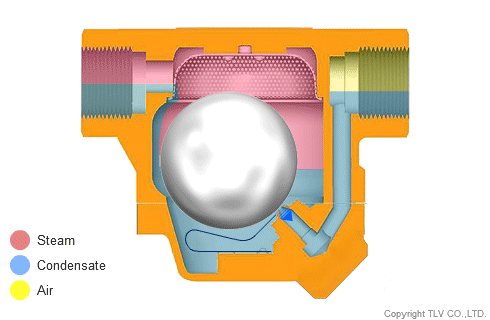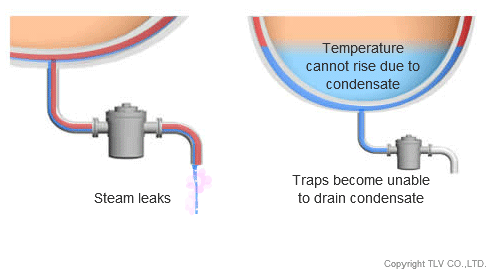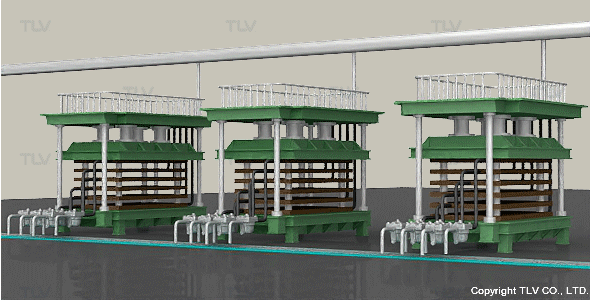- Home
- Steam Resources
- Steam Theory
- Introduction to Steam Trap Management
Steam Trap Considerations
Introduction to Steam Trap Management
All Traps are Prone to Failure
No matter how durable a steam trap may be, like any mechanical device, it will eventually need repair and/or replacement. The longer a trap is in service, the more opportunity it has to wear. This wear will lower the trap’s performance and can eventually impede operation.
Determining when a trap will fail is extremely difficult because a trap’s lifecycle can be influenced by a number of factors, including steam trap type, application, pressure, condensate load, piping configuration, and steam/condensate quality. To help prevent premature trap failure and identify failures in a timely manner, every steam-using plant should establish a steam trap management program. Such programs help optimize the steam system and minimize costs.
| The Basic Mechanism of Steam Traps |
|---|
|
|
| A properly operating steam trap will discharge condensate and incondensable gases while preventing unnecessary steam loss. |
Unlike manual valves, steam traps regulate flow automatically. They help prevent steam from leaking out of the system, while allowing condensate to flow through and be discharged.
Inspecting traps for failure does not only involve checking for condensate blockage or large steam leaks. It is also important to check for smaller leaks, and to confirm that the correct steam trap is installed properly. This includes checking trap type, pressure and temperature ratings, discharge capacity, and whether the trap has been installed according to the manufacturer’s installation instructions.
Why Monitor Steam Trap Failure?
Steam trap failure occurs when a steam trap either leaks live steam or blocks condensate discharge.
| Steam Trap Failure |
|---|
|
|
| Steam traps fail by either leaking out steam (left) or blocking condensate discharge either partially or completely (right). |
Between the two types of failure, blockage is the type that can have the greatest impact on safety, reliability, and production. When not discharged rapidly from a steam distribution system, condensate can back-up into steam headers resulting in wet steam and/or water hammer. In process heating applications, a back-up of condensate can cause the heating temperature to drop. This, in turn, may increase defects and affect product quality. Blocked traps often have a direct impact on production, which often makes them easier to identify than leaking traps.
Conversely, leaking traps do not affect heating efficiency, but rather energy efficiency. Leaking traps result in significant amounts of wasted energy and money, but often remain unnoticed or forgotten because they do not directly affect product heating.
| Wasted Energy = Wasted Money |
|---|
|
|
| Steam leakage can represent a significant waste of fuel, water, and treatment costs, and it can also greatly increase a plant's carbon footprint. |
Testing Traps
To effectively check whether steam traps are operating properly or not, an inspection needs to be performed while the steam system is running and steam traps are in operation.
Since high pressure and temperature steam is involved, the working parts of a trap cannot be inspected while a process is in operation. Surveyors therefore inspect other factors, such as:
- Trap appearance and orientation
- Trap discharge
- Temperature
- Pressure
- Vibrations (sound), etc.
For more information on how to test a steam trap, read A Guide to Steam Trap Testing.
From "Steam Trap Management" to "Condensate Discharge Location (CDL) Management"
The true aim of a steam trap management program is to ensure that steam processes run smoothly and effectively in order to maintain high-quality production and help conserve energy.
To achieve the best results, these programs should cover more than just the steam trap. Surveyors should inspect the entire condensate discharge location (CDL), making sure to examine the drainage system around the trap including all piping and valves associated with it. It is important to inspect the entire CDL to ensure that no problem areas are overlooked.
Recording and analyzing data on the performance of steam traps and CDLs is also extremely important. For example, imagine that steam trap failure rate was lowered to 10% after establishing a steam trap management program. Methods of lowering this rate further will vary depending on the specific characteristics of the failures, such as traps in the same locations failing repeatedly, or traps becoming more likely to fail after they reach a certain age. Only by analyzing data to this level of detail can a plant develop an effective strategy for optimizing their steam traps and CDLs.
To summarize, establishing a steam trap management program is important in all steam-using plants. Such a program helps conserve energy and maintain high efficiency throughout the steam system. Inspections should be regular and cover the entire condensate location to enable the greatest return possible.
TLV can help develop and implement steam trap management programs tailored to plants’ specific needs.
Contact us today to request a survey of your plant.




